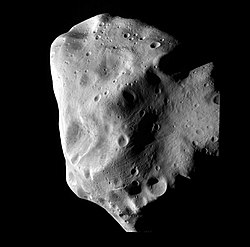Lutetia
(Lutetia : Asteroid,Discovery,exploration,origin,Surface)
21 Lutetia is a large asteroid in the asteroid belt of an
unusual spectral type. It measures about 100 kilometers in diameter (120 km
along its major axis). It was discovered in 1852 by Hermann Goldschmidt, and is
named after Lutetia, the Latin name of Paris.
Lutetia has an irregular shape and is heavily cratered, with
the largest impact crater reaching 45 km in diameter. The surface is
geologically heterogeneous and is intersected by a system of grooves and
scarps, which are thought to be fractures. It has a high average density,
meaning that it is made of metal-rich rock.
Discovery and exploration
Lutetia was discovered on November 15, 1852, by Hermann
Goldschmidt from the balcony of his apartment in Paris. A preliminary orbit for
the asteroid was computed in November–December 1852 by German astronomer Georg
Rümker and others. In 1903, it was photographed at opposition by Edward
Pickering at Harvard College Observatory. He computed an opposition magnitude
of 10.8.
There have been two reported stellar occultations by
Lutetia, observed from Malta in 1997 and Australia in 2003, with only one chord
each, roughly agreeing with IRAS measurements.[citation needed]
On July 10, 2010, the European Rosetta space probe flew by
Lutetia at a minimum distance of 3168 ± 7.5 km at a velocity of 15 kilometres
per second on its way to the comet 67P/Churyumov-Gerasimenko. The flyby
provided images of up to 60 meters per pixel resolution and covered about 50%
of the surface, mostly in the northern hemisphere. The 462 images were obtained
in 21 narrow- and broad-band filters extending from 0.24 to 1 μm. Lutetia was
also observed by the visible–near-infrared imaging spectrometer VIRTIS, and
measurements of the magnetic field and plasma environment were taken as well.
Surface features
The surface of Lutetia is covered by numerous impact craters
and intersected by fractures, scarps and grooves thought to be surface
manifestations of internal fractures. On the imaged hemisphere of the asteroid
there are a total of 350 craters with diameters ranging from 600 m to 55 km.
The most heavily cratered surfaces (in Achaia region) have a crater retention
age of about 3.6 ± 0.1 billion years.
 The surface of Lutetia has been divided into seven regions
based on their geology. They are Bactica (Bt), Achaia (AC), Etruria (Et),
Narbonensis (Nb), Noricum (Nr), Pannonia (Pa), and Raetia (Ra). The Baetica
region is situated around the north pole (in the center of the image) and
includes a cluster of impact craters 21 km in diameter as well as their impact
deposits. It is the youngest surface unit on Lutetia. Baetica is covered by a
smooth ejecta blanket approximately 600 m thick that has partially buried older
craters. Other surface features include landslides, gravitational taluses and
ejecta blocks up to 300 m in size. The landslides and corresponding rock
outcrops are correlated with variations of albedo, being generally brighter.
The surface of Lutetia has been divided into seven regions
based on their geology. They are Bactica (Bt), Achaia (AC), Etruria (Et),
Narbonensis (Nb), Noricum (Nr), Pannonia (Pa), and Raetia (Ra). The Baetica
region is situated around the north pole (in the center of the image) and
includes a cluster of impact craters 21 km in diameter as well as their impact
deposits. It is the youngest surface unit on Lutetia. Baetica is covered by a
smooth ejecta blanket approximately 600 m thick that has partially buried older
craters. Other surface features include landslides, gravitational taluses and
ejecta blocks up to 300 m in size. The landslides and corresponding rock
outcrops are correlated with variations of albedo, being generally brighter.
The two oldest regions are Achaia and Noricum. The former is
a remarkably flat area with a lot of impact craters. The Narbonensis region
coincides with the largest impact crater on Lutetia—Massilia. It includes a
number of smaller units and is modified by pit chains and grooves formed at a
later epoch. Other two regions—Pannonia and Raetia are also likely to be large
impact craters. The last Noricum region is intersected by a prominent groove 10
km in length and about 100 m deep.
The numerical simulations showed that even the impact that
produced the largest crater on Lutetia, which is 45 km in diameter, seriously
fractured but did not shatter the asteroid. So, Lutetia has likely survived
intact from the beginning of the Solar System. The existence of linear
fractures and the impact crater morphology also indicate that the interior of
this asteroid has a considerable strength and is not a rubble pile like many
smaller asteroids. Taken together, these facts suggest that Lutetia should be
classified as a primordial planetesimal.
Origin
This animation is an artist’s impression of a possible
scenario to explain how Lutetia came to now be located in the asteroid belt.
The composition of Lutetia suggests that it formed in the
inner Solar System, among the terrestrial planets, and was ejected into the
asteroid belt through an interaction with one of them.









0 comments:
Post a Comment